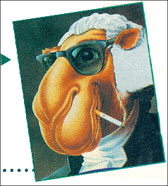 |
|
||||||||
| National Center For Chronic Disease Prevention and Health Promotion | ||||||||
|
|
||||||||
| TIPS Home | What's New | Mission | Fact Sheets | Site Map | Contact Us | ||||||||
|
|
|
|
 ©Philip Morris Inc./ Michael Newman PHOTOEDIT |
Jeremy:
"They make
it seem like you'll be tough and strong, like a cowboy, if you smoke their brand." Mick: "They show this clean, refreshing outdoor scene. They don't show the air filled with gross-smelling cigarette smoke." |
Reality Check: One of the models who played the Marlboro Man died of lung cancer. The model who played the Winston Man is paralyzed on one side because of smoking —he can no longer climb mountains like he did in those tough-guy ads. Cigarette ads are often set in clean, wholesome settings, and they never show smoke. They don't give you a clue about how gross a burning cigarette smells!
 ©1993 B&WT Co. |
Alison:
"Look at how
white her teeth are. They wouldn't really look that white if she smoked." Daniel: "People who buy the cigarettes think if they can smoke and be pretty and thin and have fun, maybe I can too." |
Reality Check: According to the SGR, "cigarette ads for women have always promoted slimness." But cigarettes are not healthy. Exercising and eating right are two of the smartest things you can do to stay fit and healthy.
 ©Lorillard 1991 |
Gabriella:
"They're
trying to show that if you smoke, you'll have a good time." Daniel: "The models are always young, good-looking, and popular." |
Reality Check: Cigarette ads have a hidden message: "Smoking helps you make friends and will make you desirable." But do you know anybody who desires someone with bad breath, smelly clothes, and yellow teeth? In one survey, 72 percent of high school seniors considered smoking a "dirty habit" — and the same number said they'd rather date someone who doesn't smoke.
 ©1992R.J. Reynolds Tobacco Co. |
Daniel:
"Camel
cigarettes uses Joe Camel, a cartoon character, to catch kids. Kids like cartoons more
than adults do." Tana: "If the cigarette companies can get kids hooked on a brand, then they just might buy that brand their whole life." |
Reality Check: The youth market is very important to the big tobacco companies, because young smokers are needed to replace older smokers who quit or die. Kids like humor, and kids like cartoons — and Camel ads use both. According to the SGR, most kids pick Camel ads as their favorite ads for cigarettes.
Cigarette ads have been banned from TV and radio since 1971. But, the tobacco companies do sponsor sporting events that are shown on TV. Then they plaster their names all over everything. During one 90-minute car race, the word "Marlboro" appeared on TV 5,933 times! How can they say that's not advertising?
 ©Philip Morris Inc. / Melanie Brown PHOTOEDIT |
Alison:
"An athlete
would never smoke, because it would affect her tennis playing." Tana: "It's a way for them to advertise without advertising — and they don't have to put the Surgeon General's warning on the signs." |
Reality Check: Six years after Virginia Slims cigarettes for women were introduced, more than twice as many teenage girls were smoking. And tobacco companies say they don't target kids!
|
|
|
Privacy Policy | Accessibility TIPS Home | What's New | About Us | Site Map | Contact Us CDC Home | Search | Health Topics A-Z This page last reviewed September 09, 2003 United States
Department of Health and Human Services |
|